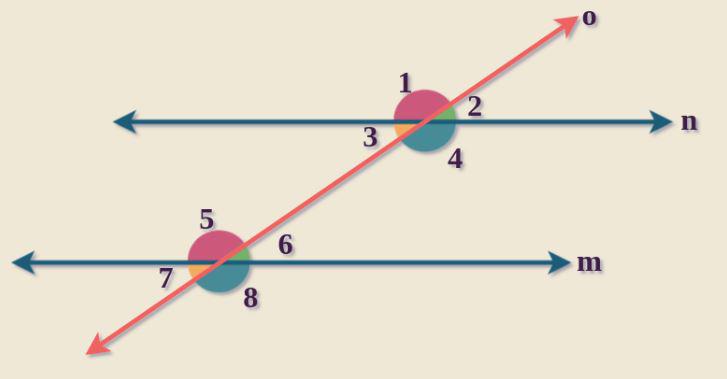
|
|
Alternate Angles are a concept in geometry that arise when two lines are crossed by another line (known as the transversal). There are two types of alternate angles i.e., Alternate Interior Angles and Alternate Exterior Angles. Alternate angles are formed when a line intersects two or more lines, and if these lines are parallel, then alternate angles are equal. In this article, we will explore the concept of alternate angles, including Alternate Interior Angles and Alternate Exterior Angles. We will also delve into the theorems related to these angles and provide proofs for them. Table of Content What are Alternate Angles?Alternate angles are a type of angle in geometry that serves as the foundation for comprehending ideas related to angles and parallel lines. Alternate angles are created on either side of a transversal that passes through two or more parallel lines. These angles are never contiguous. In this post, we will go over the appropriate definition of Alternate Angles, as well as the kinds, theorems, and some sample problems on alternate angles. Alternate Angles Definition
Alternate angles (interior), are often referred to as “Z angles” due to the Z-shape formed when a transversal intersects two parallel lines. These angles are congruent, meaning they have equal measures, when the lines are parallel. This property is a fundamental aspect of geometric proofs and problems. Properties of Alternate Angles
How to Calculate Alternate Angles?To compute with alternate angles:
Types of Alternate AnglesThe alternative angles are grouped into two sorts based on the location of the angles, namely
Alternate Interior AnglesThe pair of angles on the inner side of the two parallel lines but on the opposite side of the transversal is known as an alternate interior angle. When two lines are crossed by a third line, alternate internal angles are generated. The third line is known as the transversal line. When two parallel or non-parallel lines are crossed by a transversal line, alternate interior angles are always created. The angles are on opposing sides of the transversal line and on the inside of parallel or non-parallel lines. With the same image as previously, we can observe that pairs of opposing interior angles are represented by ∠3 & ∠6 and ∠4 & ∠5. Alternate Exterior AnglesAlternate exterior angles are the pair of angles on the outside of the two parallel lines but on the other side of the transversal. A transversal is a line formed by the intersection of two or more parallel lines. When a transversal is made over parallel lines, several pairs of angles are formed. When a transversal intersects two parallel lines, it creates four interior angles on the inside and four external angles on the outside. With the same image as previously, we can observe that pairs of opposing exterior angles are represented by ∠1 & ∠8 and ∠2 & ∠7. Alternate Angles TheoremsAccording to the alternative angle theorem, alternate interior angles or alternate exterior angles that come from crossing two parallel lines by a transversal are congruent.
Alternate Interior Angles TheoremAlternate interior angles are the angles on the inner side of the two parallel lines but on the other side of the transversal.
Proof of Alternate Interior Angles Theorem
Read More about Alternate Interior Angles. Alternate Exterior Angles TheoremThe pair of angles on the outer side of the two parallel lines but on the other side of the transversal are known as alternate exterior angles.
Proof of Alternate Exterior Angles TheoremGiven: Parallel lines AB and CD are crossed by transversal Y. [Hint: We’ll apply the following axioms: When lines are parallel, their corresponding angles are congruent, and when corresponding angles are congruent, the lines are parallel.] To prove: ∠1 = ∠8
Proof: Let’s investigate the link between these angles by looking at their relationships to other angles. ∠1 and its vertically opposite ∠4 create a critical relationship. Knowing that ∠1 corresponds to ∠4 (due to vertical angles) and that lines AB and CD are parallel: ∠4 corresponds to ∠8 (corresponding angles axiom). As a result, by clicking on this link: Because of transitivity, ∠1 equals ∠8. As a result, ∠1 and ∠8 on parallel lines cut by transversal Y are definitely equal! Read more about Alternate Exterior Angles. Alternate Angles and Corresponding AnglesAngles generated by a transversal intersecting two lines are known as alternate angles and matching angles. Here are the major differences between them, as shown in a table:
Read More, Alternate Angles ExamplesExample 1: It is stated that the two matching angles are 7x+20 and 97. What does x represent? Solution:
Example 2: The values of two similar angles, ∠3 = 7x+8 and ∠4 = 5x+16. Determine the value of x via calculating. Solution:
Example 3: Find the Value of ∠X, ∠W, and ∠Z . If line AB || line CD and line LM is intersected over it and the value of ∠Y = 80°. Solution:
Example 4: If the alternate exterior angles are indicated as (5x + 55)° and (6x – 65)° in a given set of two parallel lines cut by a transversal, calculate the value of x and the true value of the alternate exterior angles using the alternate exterior angles theorem. Answer:
Example 5: Demonstrate that the interior angles (4x + 64) ° and (5x – 98) ° are congruent. Answer:
FAQs of Alternate AnglesWhat is meant by Alternate Angles?
Do Alternate Angles add to 180°?
What are Alternate Interior Angles?
What are Alternate Exterior Angles?
How do you find Alternate Angles?
What is Z Rule for Angles?
|
||||||||||||
Reffered: https://www.geeksforgeeks.org
| Class 9 |
Type: | Geek |
Category: | Coding |
Sub Category: | Tutorial |
Uploaded by: | Admin |
Views: | 13 |


